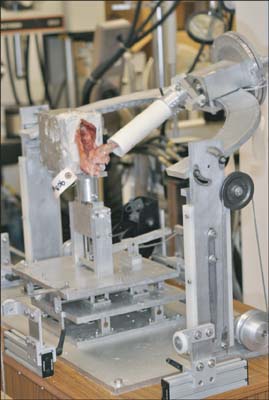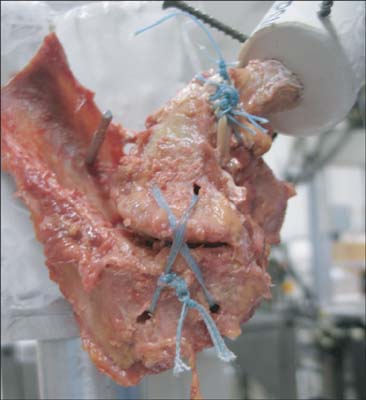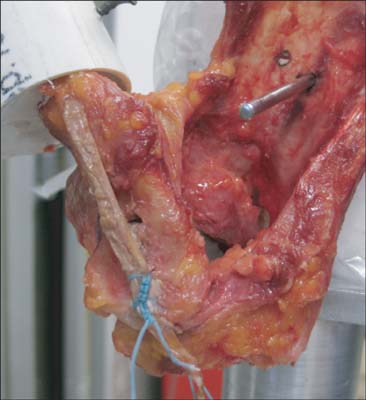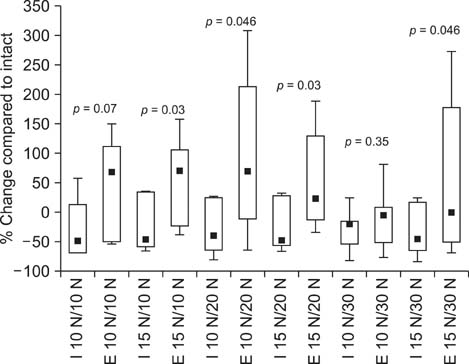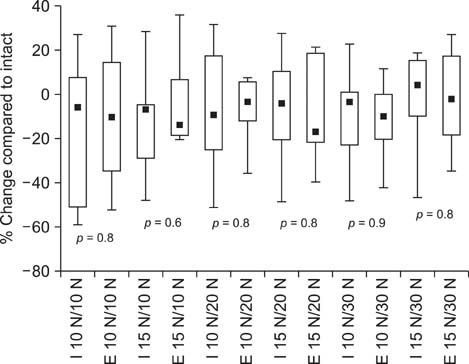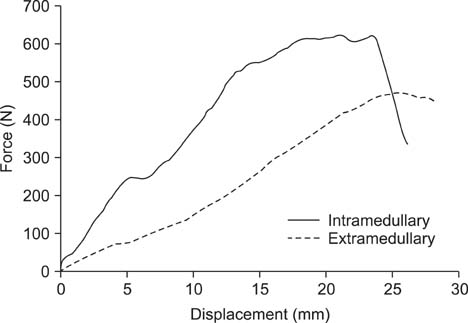Clin Orthop Surg.
2013 Dec;5(4):298-305. 10.4055/cios.2013.5.4.298.
Biomechanical Comparison of an Intramedullary and Extramedullary Free-Tissue Graft Reconstruction of the Acromioclavicular Joint Complex
- Affiliations
-
- 1Orthopaedic Biomechanics Laboratory, Long Beach VA Healthcare System and University of California, Irvine, CA, USA. rishigargmd@gmail.com
- 2Congress Medical Associates, Pasadena, CA, USA.
- KMID: 1787033
- DOI: http://doi.org/10.4055/cios.2013.5.4.298
Abstract
- BACKGROUND
Several different surgical techniques have been described to address the coracoclavicular (CC) ligaments in acromioclavicular (AC) joint injuries. However, very few techniques focus on reconstructing the AC ligaments, despite its importance in providing stability. The purpose of our study was to compare the biomechanical properties of two free-tissue graft techniques that reconstruct both the AC and CC ligaments in cadaveric shoulders, one with an extramedullary AC reconstruction and the other with an intramedullary AC reconstruction. We hypothesized intramedullary AC reconstruction will provide greater anteroposterior translational stability and improved load to failure characteristics than an extramedullary technique.
METHODS
Six matched cadaveric shoulders underwent translational testing at 10 N and 15 N in the anteroposterior and superoinferior directions, under AC joint compression loads of 10 N, 20 N, and 30 N. After the AC and CC ligaments were transected, one of the specimens was randomly assigned the intramedullary free-tissue graft reconstruction while its matched pair received the extramedullary graft reconstruction. Both reconstructed specimens then underwent repeat translational testing, followed by load to failure testing, via superior clavicle distraction, at a rate of 50 mm/min.
RESULTS
Intramedullary reconstruction provided significantly greater translational stability in the anteroposterior direction than the extramedullary technique for four of six loading conditions (p < 0.05). There were no significant differences in translational stability in the superoinferior direction for any loading condition. The intramedullary reconstructed specimens demonstrated improved load to failure characteristics with the intramedullary reconstruction having a lower deformation at yield and a higher ultimate load than the extramedullary reconstruction (p < 0.05).
CONCLUSIONS
Intramedullary reconstruction of the AC joint provides greater stability in the anteroposterior direction and improved load to failure characteristics than an extramedullary technique. Reconstruction of the injured AC joint with an intramedullary free tissue graft may provide greater strength and stability than other currently used techniques, allowing patients to have improved clinical outcomes.
MeSH Terms
Figure
Reference
-
1. Rockwood CA Jr, Williams GR Jr, Young DC. Disorders of the acromioclavicular joint. In : Rockwood CA, Matsen FA, Wirth MA, Lippitt SB, editors. The shoulder. 3rd ed. Philadelphia, PA: WB Saunders;2004. p. 521–595.2. Breslow MJ, Jazrawi LM, Bernstein AD, Kummer FJ, Rokito AS. Treatment of acromioclavicular joint separation: suture or suture anchors? J Shoulder Elbow Surg. 2002; 11(3):225–229.
Article3. Costic RS, Labriola JE, Rodosky MW, Debski RE. Biomechanical rationale for development of anatomical reconstructions of coracoclavicular ligaments after complete acromioclavicular joint dislocations. Am J Sports Med. 2004; 32(8):1929–1936.
Article4. Deshmukh AV, Wilson DR, Zilberfarb JL, Perlmutter GS. Stability of acromioclavicular joint reconstruction: biomechanical testing of various surgical techniques in a cadaveric model. Am J Sports Med. 2004; 32(6):1492–1498.
Article5. Harris RI, Wallace AL, Harper GD, Goldberg JA, Sonnabend DH, Walsh WR. Structural properties of the intact and the reconstructed coracoclavicular ligament complex. Am J Sports Med. 2000; 28(1):103–108.
Article6. Jari R, Costic RS, Rodosky MW, Debski RE. Biomechanical function of surgical procedures for acromioclavicular joint dislocations. Arthroscopy. 2004; 20(3):237–245.7. Lee SJ, Nicholas SJ, Akizuki KH, McHugh MP, Kremenic IJ, Ben-Avi S. Reconstruction of the coracoclavicular ligaments with tendon grafts: a comparative biomechanical study. Am J Sports Med. 2003; 31(5):648–655.8. Lim YW, Sood A, van Riet RP, Bain GI. Acromioclavicular joint reduction, repair and reconstruction using metallic buttons: early results and complications. Tech Shoulder Elbow Surg. 2007; 8(4):213–221.9. Mazzocca AD, Santangelo SA, Johnson ST, Rios CG, Dumonski ML, Arciero RA. A biomechanical evaluation of an anatomical coracoclavicular ligament reconstruction. Am J Sports Med. 2006; 34(2):236–246.10. Mumford EB. Acromioclavicular dislocation: a new operative treatment. J Bone Joint Surg Am. 1941; 23(4):799–802.11. Noyes FR, Butler DL, Grood ES, Zernicke RF, Hefzy MS. Biomechanical analysis of human ligament grafts used in knee-ligament repairs and reconstructions. J Bone Joint Surg Am. 1984; 66(3):344–352.12. Struhl S. Double endobutton technique for repair of complete acromioclavicular joint dislocations. Tech Shoulder Elbow Surg. 2007; 8(4):175–179.13. Tsou PM. Percutaneous cannulated screw coracoclavicular fixation for acute acromioclavicular dislocations. Clin Orthop Relat Res. 1989; (243):112–121.14. Weaver JK, Dunn HK. Treatment of acromioclavicular injuries, especially complete acromioclavicular separation. J Bone Joint Surg Am. 1972; 54(6):1187–1194.15. Debski RE, Parsons IM 4th, Woo SL, Fu FH. Effect of capsular injury on acromioclavicular joint mechanics. J Bone Joint Surg Am. 2001; 83(9):1344–1351.16. Fukuda K, Craig EV, An KN, Cofield RH, Chao EY. Biomechanical study of the ligamentous system of the acromioclavicular joint. J Bone Joint Surg Am. 1986; 68(3):434–440.17. Klimkiewicz JJ, Williams GR, Sher JS, Karduna A, Des Jardins J, Iannotti JP. The acromioclavicular capsule as a restraint to posterior translation of the clavicle: a biomechanical analysis. J Shoulder Elbow Surg. 1999; 8(2):119–124.18. Lee KW, Debski RE, Chen CH, Woo SL, Fu FH. Functional evaluation of the ligaments at the acromioclavicular joint during anteroposterior and superoinferior translation. Am J Sports Med. 1997; 25(6):858–862.19. Urist MR. Complete dislocations of the acromiclavicular joint: the nature of the traumatic lesion and effective methods of treatment with an analysis of forty-one cases. J Bone Joint Surg Am. 1946; 28(4):813–837.20. Grutter PW, Petersen SA. Anatomical acromioclavicular ligament reconstruction: a biomechanical comparison of reconstructive techniques of the acromioclavicular joint. Am J Sports Med. 2005; 33(11):1723–1728.21. Tienen TG, Oyen JF, Eggen PJ. A modified technique of reconstruction for complete acromioclavicular dislocation: a prospective study. Am J Sports Med. 2003; 31(5):655–659.22. Adamson GJ, Freedman JA, Lee TQ. Free tissue graft reconstruction of the acromioclavicular joint: a new technique. Tech Shoulder Elbow Surg. 2008; 9(4):193–198.23. Michlitsch MG, Adamson GJ, Pink M, Estess A, Shankwiler JA, Lee TQ. Biomechanical comparison of a modified Weaver-Dunn and a free-tissue graft reconstruction of the acromioclavicular joint complex. Am J Sports Med. 2010; 38(6):1196–1203.24. Dawson PA, Adamson GJ, Pink MM, et al. Relative contribution of acromioclavicular joint capsule and coracoclavicular ligaments to acromioclavicular stability. J Shoulder Elbow Surg. 2009; 18(2):237–244.25. Freedman JA, Adamson GJ, Bui C, Lee TQ. Biomechanical evaluation of the acromioclavicular capsular ligaments and reconstruction with an intramedullary free tissue graft. Am J Sports Med. 2010; 38(5):958–964.26. Remia LF, Ravalin RV, Lemly KS, McGarry MH, Kvitne RS, Lee TQ. Biomechanical evaluation of multidirectional glenohumeral instability and repair. Clin Orthop Relat Res. 2003; (416):225–236.27. Costic RS, Jari R, Rodosky MW, Debski RE. Joint compression alters the kinematics and loading patterns of the intact and capsule-transected AC joint. J Orthop Res. 2003; 21(3):379–385.28. Turman KA, Miller CD, Miller MD. Clavicular fractures following coracoclavicular ligament reconstruction with tendon graft: a report of three cases. J Bone Joint Surg Am. 2010; 92(6):1526–1532.29. Gonzalez R, Damacen H, Nyland J, Caborn D. Acromioclavicular joint reconstruction using peroneus brevis tendon allograft. Arthroscopy. 2007; 23(7):788.e1–788.e4.30. Corteen DP, Teitge RA. Stabilization of the clavicle after distal resection: a biomechanical study. Am J Sports Med. 2005; 33(1):61–67.
- Full Text Links
- Actions
-
Cited
- CITED
-
- Close
- Share
- Similar articles
-
- Concomitant Acromioclavicular and Coracoclavicular Ligament Reconstruction with a Duo-Figure-8 Autogenic Graft Wrapping Technique for Treating Chronic Acromioclavicular Separation
- Neglected Type IV Acromioclavicular Joint Injury: 2 Cases Report
- The Effects of Extramedullary Reduction in Unstable Intertrochanteric Fracture: A Biomechanical Study Using Cadaver Bone
- Treatment of Acromioclavicular Joint Dislocations: Focus on the Reduction of Acromioclavicular Joint
- The Treatment of Grade 3 Acute Acromioclavicular Joint Injuries with Modified Neviaser Technique

